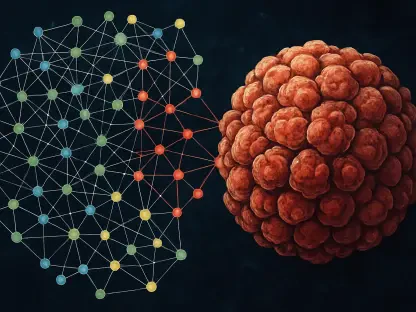In a significant leap forward for oncology, the U.S. Food and Drug Administration (FDA) has given the green light to Astellas Pharma Inc.’s VYLOY (zolbetuximab-clzb) for treating adults with advanced, unresectable, or metastatic human epidermal growth factor receptor 2 (HER2)-negative gastric or gastroesophageal junction (GEJ) adenocarcinoma. This approval is especially groundbreaking as it marks the first targeted therapy for tumors positive for claudin (CLDN) 18.2.
The Groundbreaking Approval
Introduction to VYLOY
VYLOY, the newly FDA-approved treatment, is set to revolutionize therapeutic approaches for advanced gastric cancers. Unlike traditional treatments, VYLOY combines with fluoropyrimidine- and platinum-containing chemotherapy to target CLDN18.2 positive tumors. This specificity is crucial, offering a beacon of hope for patients with limited treatment options. Being able to specifically target CLDN18.2 positive tumors means that the treatment is tailored to the molecular characteristics of the cancer, ensuring a more precise and effective intervention.
The approval of VYLOY is not just a routine regulatory decision; it is a beacon of hope for patients who previously had limited options. The combination with standard chemotherapy drugs considerably enhances the therapeutic effects, potentially transforming treatment paradigms. Astellas Pharma Inc. has meticulously developed VYLOY to address the pressing need for more effective therapies in a demographic that often grapples with poor prognosis and limited survival rates.
Importance of CLDN18.2 Biomarker
The inclusion of the claudin (CLDN) 18.2 biomarker is a pivotal aspect of this therapy. Biomarkers like CLDN18.2, detectable through the FDA-approved VENTANA CLDN18 (43-14A) RxDx Assay from Roche, allow for precision in treatment that was previously unattainable. The new diagnostic capabilities ensure accurate patient identification, paving the way for more reliable and effective treatments. The ability to pinpoint patients through advanced diagnostics means that VYLOY can be administered more effectively, potentially reducing wastage and enhancing therapeutic outcomes.
This biomarker’s identification has profound implications not only for VYLOY but also for future cancer treatment strategies. With the knowledge that tumors overexpressing CLDN18.2 can be specifically targeted, the medical community can focus on developing more therapies that leverage molecular markers. This could herald a new era in oncology, where treatments are increasingly individualized, reducing the trial-and-error approach that has long plagued cancer therapy.
Clinical Trials Underscoring VYLOY’s Efficacy
SPOTLIGHT and GLOW Trials
The FDA’s approval of VYLOY predominantly hinges on the promising results from its Phase 3 SPOTLIGHT and GLOW clinical trials. Both studies rigorously evaluated the combination of VYLOY with chemotherapy, reporting significant improvement in progression-free survival (PFS) and overall survival (OS) rates. These findings mark VYLOY as a superior option compared to conventional chemotherapy alone. The SPOTLIGHT trial, for instance, showcased nearly double the median PFS compared to the control group, a testament to the drug’s efficacy.
The GLOW trial also offered compelling evidence supporting VYLOY’s efficacy. Patients in this trial experienced an improvement in overall survival rates, a critical measure of treatment success in oncology. The combined data from both trials were pivotal in convincing the FDA of VYLOY’s substantial benefits, granting it the approval needed to become a first-line treatment option. These trials collectively mean that patients now have access to a therapy that not only extends life but also potentially improves the quality of those additional months or years.
Detailed Trial Outcomes
The SPOTLIGHT and GLOW clinical trials enrolled hundreds of patients worldwide, meticulously analyzing the outcomes of different treatment combinations. The results were overwhelmingly positive, with those receiving VYLOY showing notable extension in both PFS and OS. This underscores the drug’s potential in altering the treatment landscape for this patient demographic. Detailed analyses revealed that VYLOY, when combined with conventional chemotherapy, led to a statistically significant reduction in tumor size for many patients.
Moreover, the trials highlighted the manageable side effect profile of VYLOY, an important consideration for any new treatment. Nausea, vomiting, and decreased appetite were the most frequently reported adverse effects, consistent with those experienced in other chemotherapies. However, these side effects were generally moderate and manageable, further solidifying VYLOY’s role as a viable and preferable treatment option. These detailed trial outcomes have essentially paved the way for a new gold standard in managing advanced gastric and GEJ cancers.
Impact on Patients and Healthcare Providers
Addressing Unmet Medical Needs
Advanced gastric and GEJ adenocarcinomas have historically presented significant treatment challenges due to a lack of targeted therapies. The FDA’s approval of VYLOY directly addresses this gap, providing an essential new option for patients whose tumors are CLDN18.2 positive. This novel approach not only extends survival but also improves the quality of life for patients battling these aggressive cancers. For many, this could mean more precious time spent with loved ones, better symptom management, and renewed hope.
The medical community has long awaited a breakthrough in this challenging field. VYLOY’s approval offers a much-needed reprieve, opening up new horizons for treatment protocols. By focusing on a specific biomarker, physicians can now provide a more tailored treatment plan, improving outcomes and offering a sense of control over a previously unpredictable disease progression. This development is a monumental step in closing the gap between existing treatment approaches and the evolving needs of patients.
Perspectives from the Medical Community
Medical professionals have lauded the approval of VYLOY, viewing it as a pivotal advancement in oncology. Dr. Moitreyee Chatterjee-Kishore from Astellas highlights the relentless pursuit of scientific innovation, while Dr. Samuel J. Klempner emphasizes the clinical impact this new treatment will have. The collective optimism from the medical community underscores the anticipated benefits for patients. Experts believe that VYLOY’s role in first-line treatment protocols could significantly shift clinical practices, offering a new benchmark for future therapies.
The approval has catalyzed discussions about the future of cancer treatment, particularly for cancers previously considered intractable. The excitement is palpable as doctors and researchers look forward to integrating VYLOY into their clinical practice. With the backing of robust clinical trial data, healthcare providers are ready to embrace this new option, outlining protocols, and educating patients about the potential benefits and risks associated with VYLOY therapy. The endorsement from the medical community serves as a powerful validation of VYLOY’s transformative potential.
Broader Trends in Oncology
Precision Medicine: The Future of Treatment
The approval of VYLOY signifies a broader trend in the field of oncology towards precision medicine. By developing treatments tailored to specific genetic and protein markers, researchers and healthcare providers can offer more effective and individualized patient care. This shift towards personalized medicine represents a profound evolution in cancer treatment strategies. Precision medicine offers the promise of customized treatments that align more closely with the biological and genetic makeup of the patient’s cancer, improving the odds of successful outcomes.
The focus on precision medicine is a testament to the ongoing advancements in diagnostic technologies and molecular biology. Researchers are increasingly able to identify actionable biomarkers and develop therapies that directly target these markers. As a result, the once generic approach to cancer treatment is being replaced with more sophisticated and specialized strategies. This trend not only enhances the efficacy of treatments but also minimizes unnecessary side effects, offering a better quality of life for patients undergoing therapy.
The Role of Collaborative Research
In a major advancement for cancer treatment, the U.S. Food and Drug Administration (FDA) has approved Astellas Pharma Inc.’s VYLOY (zolbetuximab-clzb) for adult patients with advanced, unresectable, or metastatic human epidermal growth factor receptor 2 (HER2)-negative gastric or gastroesophageal junction (GEJ) adenocarcinoma. This approval is historic as VYLOY becomes the first ever-targeted therapy approved specifically for tumors expressing claudin (CLDN) 18.2. Gastric cancer, including this type, represents a significant challenge in oncology due to its typically late diagnosis and limited effective treatment options.
The development and approval of VYLOY offer new hope for patients battling these aggressive forms of cancer. Astellas Pharma Inc. has highlighted that this breakthrough represents not just a critical expansion in treatment possibilities but also underscores the importance of continuous innovation and targeted therapies in oncology. As this new treatment enters the market, it sets a precedent for future advancements and opens doors for more research focusing on targeted mechanisms to combat debilitating cancers.









